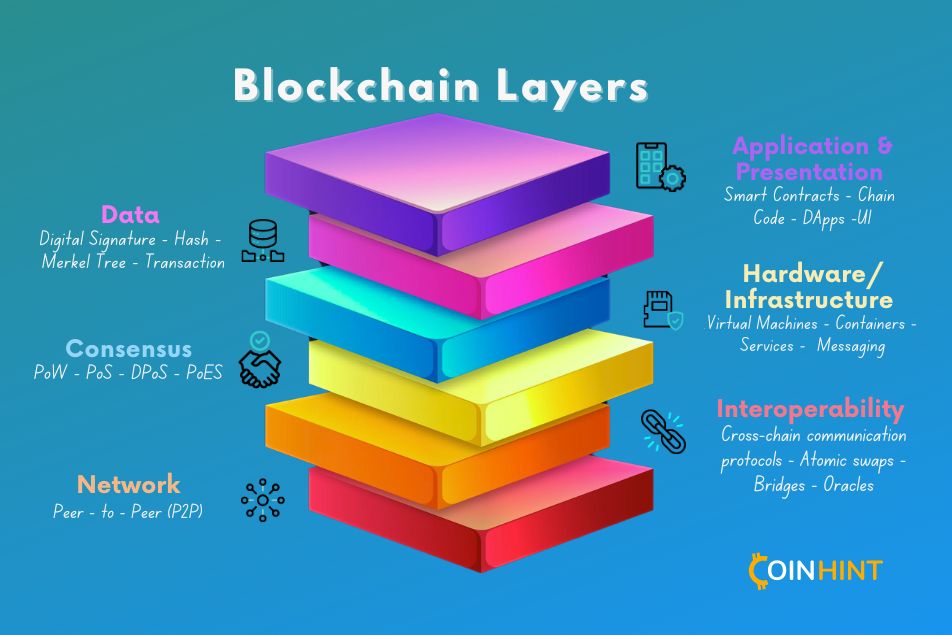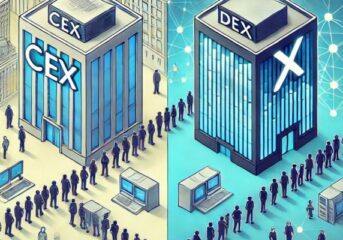What Are Blockchain Layers and How Do They Work?
Everyday interactions with the blockchain range from regular p2p transactions to running a node or deploying an application. For the most advanced users, regular interaction could also include building a new blockchain network or refining existing networks. The blockchain is a system of diverse units functioning in synergy to produce one of the most advanced data management tools. These units are known as the “Layers” of the blockchain. This article gives an overview of blockchain networks, unraveling how the compact blockchain system comprises several split but unified units.

What Are Blockchain Layers?
Blockchain layers are factions of decentralized networks. Decentralized ledger technology (DLT) enables data to be stored and managed in a community-owned network. This network is a collection of hundreds to millions of people and several units that handle key operations to achieve a dynamic and functional system. The Blockchain layer is an autonomous but interconnected part of the whole network that plays a role in the coordination of the ‘people’ and the network facilities, securing and scaling the network, as well as storing data.
The Hardware Layer
A blockchain network is upheld by several interconnected physical computer devices all over the world. Each device holds a copy of the blockchain network and runs the network client to validate data stored on the network from time to time. This interconnected computer structure is known as the hardware or infrastructure layer of the blockchain.
The operation of these computers is known as crypto mining or validation. Crypto miners or validators run a network node. Depending on the type of node they run (full, light, or archival), they store a part or the whole of the network’s record and participate in adding new data to the network.
The Data Layer
The data layer handles the records created on the blockchain network. For a usual blockchain, data generated on the network includes p2p transfers, smart contract operations, and other requests for computing. The data layer manages these records using different approaches. For instance, the Bitcoin blockchain records data generated on the network in lists while the Ethereum blockchain uses the Merkle tree data structure to handle records created on its network.
The data layer contributes to the sanity and immutability of the blockchain network by arranging this data properly and ensuring that it cannot be reordered by bad actors.
The Network Layer
The network layer is also known as the p2p layer, it unifies the operators of the blockchain’s hardware. The network layer creates a communication path for nodes on a decentralized network, it handles the node discovery process, ensuring that nodes on the network can find each other, share the network’s records, and synchronize to a uniform state. This process can also be described as block propagation, the network layer maintains the integrity of the blocks through a Trusted Execution Environment (TEE). The network layer contributes to the efficiency of the blockchain network, the time taken for nodes to locate one another could influence the time taken to process network data.
The Consensus Layer
The consensus layer oversees the rest of the blockchain network. It ensures that the network maintains a uniform state through a decentralized decision system. Nodes on the network decide on the network state and synchronize uniformly to the agreed state. The consensus layer arranges the data blocks generated in the data layers. It identifies them using a hashing system and adds them to the network after validating them. The hashing algorithm identifies each block with a progressive code, ensuring that the blocks cannot be reworked except in a (successful) 51% attack. It uses a consensus algorithm to manage the agreement process. This algorithm differs across blockchain networks but requires validators or miners to share proof that they have reviewed the block and hashed it, then distribute rewards as specified to the node operators.
The Application Layer
The application layer turns the blockchain network into a platform on which advanced software programs can be built. Through a virtual machine, a blockchain network can power diverse applications through smart contracts. Smart contract codes automate blockchain operations and can manage assets on behalf of users. Developers leverage this ability to build decentralized applications in sectors like DeFi (crypto staking, on-chain swaps, lending etc.), GameFi, AI, and DePIN. These applications utilize the blockchain network as a back-end and for data storage, they communicate with the network via APIs.
Contemporary decentralized applications are designed with the usual web2 interface. However, they package advanced web3 interactions into simplified operations to enable anyone to interact with the blockchain network via their interface. They are also equipped with special connectivity features to maintain the network and asset security as users interact with them.
Blockchain Architecture
The blockchain is a progressive network made up of layers in sequential operation. The blockchain is designed to compute transactions and store records of these transactions in a secure and immutable medium. The blockchain architecture is built to reflect these goals. First, to avoid the single point of failure seen in centralized systems, the blockchain data is verified by several people who form the base of the network’s security and decentralization. Other layers of the network handle the storage, verification, and retrieval of this data.
Layer 0
The layer 0 is the foundation of the blockchain. It features blockchain primitives like consensus mechanisms. It sets the ground for an operational blockchain network through technologies that enable other advanced utilities to be built. Layer 0 focuses on scaling the efficiency of a blockchain network. Contemporary Layer 0 implementations attempt to create cross-chain interoperability protocols. Networks like Cosmo Hub and Polkadot are Layer 0 implementations, they provide a platform for complete blockchain networks to operate and interact with each other.
Layer 1 – The Data Layer
What Is the Data Layer?
The data layer handles the records created on the blockchain network. It oversees and arrangement and relaying of network data to other layers of the blockchain. Data generated on the blockchain is mainly transactional data from regular P2P operations, smart contract operations, and external data feeds from decentralized Oracle networks. The data layer contributes significantly to the network’s security by correctly ordering the data and presenting it accurately.
How the Data Layer Works
The operation of the Data layer differs across blockchain networks. Blockchain networks adopt data structure algorithms that suit their operations. For instance, the Bitcoin blockchain arranges the network data in lists while the Ethereum network uses the Merkle tree data structure to order network data. Merkle Tree uses a hashing algorithm to create a digital footprint of data in a network, this allows anyone to verify any record on the network using the hashcode of the data.
Examples of Data Layer Implementations
An example of contemporary Data Layer implementations includes Proof of Reserve (POR) technology and Data Availability solutions. These solutions adopt the system used by the blockchain data layers. For instance, the POR technology enables anyone to verify that a custodial exchange is truly in the custody of their funds. Data Availability (DA) solutions hold network data for easy verifiability, ensuring that other factions of the decentralized network can easily sort and validate network data.
Layer 2 – The Consensus Layer
The second layer of the blockchain network is the consensus layer.
What Is the Consensus Layer?
The consensus distributes the control of the blockchain (equally) to the different network participants. It uses a consensus mechanism to select a validator to screen and hash new blocks to the network. The consensus layer ensures that every node on the network agrees to a uniform state. It is the most important layer in a blockchain network and is required for any form of decentralized network.
Different Consensus Mechanisms
Some of the notable consensus mechanisms used by blockchain networks include
Proof of Work (POW): Used by older blockchain networks like Bitcoin. Miners are required to solve a mathematical puzzle using brute force. The Miner who solves the puzzle is selected to validate the block and receive rewards.
Proof of Stake (POW): Validators stake tokens on the network and are randomly chosen to validate a block.
Proof of History (POW): Used by Solana network. It uses the Verifiable Delay Function (VDF) to generate timestamps for the blocks in the Blockchain network.
Security and Scalability Considerations
The mechanism used by the consensus layer contributes significantly to the network’s security and scalability. The POW is considered a more secure mechanism but is resource-intensive and scores low in scalability and agility. POS is a more scalable mechanism but scores low in security and decentralization.
Layer 3 – The Network Layer
The third layer of the blockchain is the Network layer
What Is the Network Layer?
The network layer creates a connection between nodes on a blockchain, allowing them to propagate the network data and store required data. The node layers ensure a stable inter-node connection and communication.
Network Layer Protocols
Network Layer protocols enable node operators to create and manage their nodes. They are blockchain clients and are native software applications with an interface for every key activity of a blockchain node operator.
Challenges in the Network Layer
The blockchain is usually a high-memory capacity network. The size of a network could grow to several gigabytes. Node operators are required to download and run a significant part of the network. Most blockchains enable validators and miners to only download selected networks during the synchronization. They are known as light nodes. Regardless, this still takes up significant disk space.
Layer 4 – The Incentive Layer
The fourth layer of the blockchain is the incentive layer.
What Is the Incentive Layer?
The incentives handle the reward system of the blockchain. It is usually categorized as part of the consensus layer. Miners and validators receive rewards for validating the network data. The incentive layer distributes the rewards and applies financial penalties, when due.
Types of Incentives
There are two broad classes of blockchain incentives, which include:
Monetary Incentives
These are token rewards accorded to a validator or miner on the network. After the recent halving miners on the Bitcoin receive 6.25BTC per block mined.
Non-monetary Incentives
Non-monetary incentives are the non-token benefits a network participant receives for contributing to the network. This could be a growth in their reputation or other privileges.
Layer 5 – The Application Layer
The fifth layer of the blockchain is the application layer
What Is the Application Layer?
The application layer enables software programs to interact with the blockchain network. They are also categorized together with the contract layer as these decentralized applications (DApps) are encoded agreements between the user and the platform to manage their assets on their behalf. It enables these applications to change the users’ balance by communicating with the blockchain through APIs.
Examples of dApps
Some examples of decentralized applications include:
DeFi applications like Uniswap, Aave, and Jupiter exchange. They enable users to perform financial operations like asset swaps and lending on the blockchain.
GameFi applications like Axie Infinite and Illuvium enable gamers to play games and manage their game items on the blockchain.
Advanced Blockchain Layers and Innovations
The usual blockchain networks like Ethereum, Bitcoin, and Solana are of the Layer-1 class. These consist of the five layers of the blockchain network and are built to suit the purpose of the network. Advancements in the blockchain space expand the concept of blockchain layers. Layer-2 and Layer-3 blockchain networks have emerged over the years as a fix to the performance issues associated with layer-1.
Layer-2
Layer-2 blockchains are built on top of layer-1 blockchains. They are focused on improving speed and cost efficiency while maintaining the same level of security and decentralization on the Layer-1 network. They are also known as layer-2 scaling solutions. Notable Layer-2 blockchains include layer-2 rollup networks like Arbitrum, Zksync, and Optimism. They create an external execution environment to handle transactions faster and then bundle the transaction data for final validation on the L-1 network using rollup technologies. Other Layer-2 networks include the Bitcoin Lightning network and other networks powered by state channel and sidechain technologies.
Layer-3
Layer-3 blockchains are built on layer-2 blockchains. They extend the high throughput of L-2 networks and improve on areas like speed and interoperability. Layer-3 networks like Arbitrum Orbit and Zksync parachains are built on the Arbitrum and Zksync Layer-2 networks respectively. They are capable of hosting high-performance applications like decentralized games, DeFi applications, and other utility applications.
Why Understanding Blockchain Layers is Important
Current and projected improvements to how a blockchain network functions are simply fixes for the shortcomings of at least one of the key layers of the blockchain. A good knowledge of these layers is therefore important to understanding how a blockchain network works. Each layer makes up a blockchain unit, but individually, they function as another unit and are then connected to the general system. ‘
As a developer, an understanding of the structure is important for structuring decentralized applications or new blockchains. As a regular blockchain user, each operation performed on the blockchain interacts with at least three of the five blockchain layers, so a good understanding of how user operations interact with these units is important as they help users refine their operations when necessary.
The Future of Blockchain Layers
Recent developments in the blockchain space have improved the way we see the blockchain system, from a compact system to the layered network that it truly is. This has led to innovations such as the layer-2 network for Ethereum and the much older Bitcoin network. Other solutions such as Layer-0 solutions for interoperability and standalone blockchain networks that copy older blockchains and improve a few layers of the network. Going into the future, our CoinHint.com analysts expect this practice to continue. They anticipate that the different layers of the blockchain will be treated as containers in an application that can be taken apart and developed individually to achieve a more efficient and scalable blockchain network. This could change the trajectory for blockchain evolution from the creation of new blockchain networks to the creative improvement of existing blockchains.
Conclusion
Blockchain technology is penetrating the most important sectors of our contemporary society. The blockchain fits several use cases and this is made possible by the several layers. Each layer plays a key role in the system. While blockchains might differ in throughput and constituents, they adopt this basic structure. In this article, we have explored each layer of the blockchain network and reflected on the role each plays in the current state of the blockchain, and how they could influence revolutionary developments in the ways the blockchain functions.
FAQ
-
What is the most critical layer in blockchain architecture?
The consensus layer is the most critical in blockchain architecture, as it validates activities on other layers and resolves the network to a uniform state. The immutability feature that the blockchain holds in esteem is a product of the consensus layer. This layer coordinates the blockchain as well as the consensus committee (miner or validators) and the network’s economy.
-
How do blockchain layers affect scalability?
The overall scalability and efficiency of a blockchain system are defined by the efficiency of each layer. The algorithm used by the consensus layer, the data management technology used by the data layer, and the computing structure used by the virtual machine in the application. Each of these defines how the blockchain operates and how well it handles increasing workload.
-
Can new layers be added to an existing blockchain?
The blockchain is a rigid system. While adding new layers to an existing blockchain is possible, this is not a straightforward process. Adding a new layer to a blockchain system requires creative work-throughs. An example is layer-2 scaling solutions which add a new layer to a blockchain network by creating an external execution environment and connecting it to an existing network.








